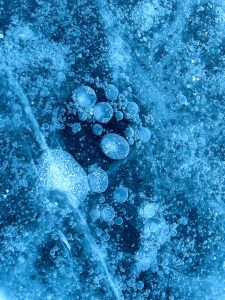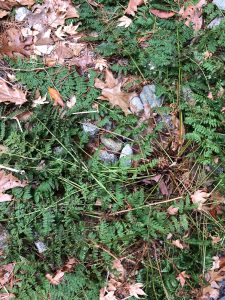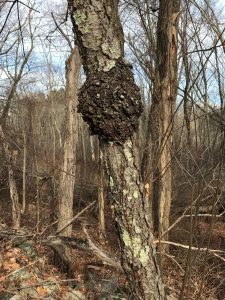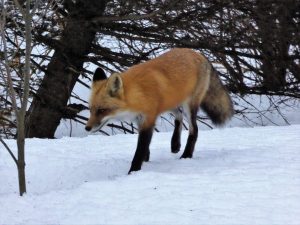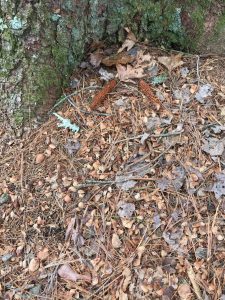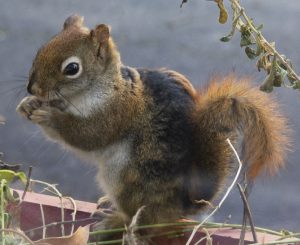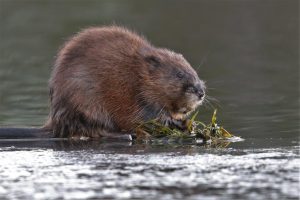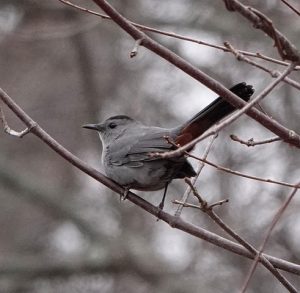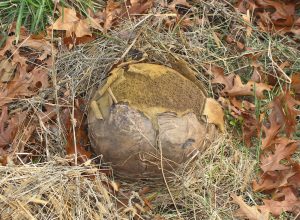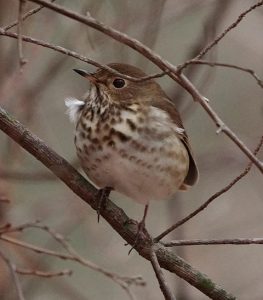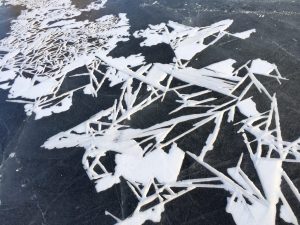Written by Gwyn Loud for the Lincoln Land Conservation Trust. She welcomes your sightings and questions at 781-259-8690 or gwynloud555@gmail.com.
The two snow storms of December are behind us and the lingering patches of snow have melted slowly, due to prolonged cold days. Ponds are frozen. This is a good season for us to notice less obvious beauties of nature, perhaps patterns in bark and ice, fungi, lichen, evergreen ferns, or the different conifers in our landscape. You might come across a midden, a pile of pine cones stripped, with scales left by a red squirrel who was eating seeds from cones at the base of a tree. Or look for burls on tree trunks, irregular bulbous swellings, triggered by bacteria, fungi, or insects laying eggs. There are three local species of ferns which stay green all winter, the most common being intermediate wood fern, whose fronds lie flat on the ground at this season. In the weeks since the winter solstice the hours of daylight are noticeably longer and the sun is a bit higher in the sky. Birds’ songs are triggered by these changes rather than temperature; already we can hear the twittering of house finches or the two-note “fee bee” call of chickadees, and bluebirds are investigating bird boxes to check out the real estate.
Observers have reported seeing red foxes from many parts of town and I have heard their wild calls at night. They have many vocalizations, from barks to screams or wails, some related to their mating season in January and February. A resident of Birchwood Lane wrote, “I was standing along the edge of the woods with my dog and I heard a high-pitched bark behind me. I turned around to see a fox running in the woods toward me. When he saw me (at about 10-15 yards) he turned and ran back the way he had come. He continued to bark and I could follow the sound all through the woods. It went on for several minutes. He wasn’t being chased. He didn’t appear ill or injured.” If you think you are smelling skunks right now it is probably fox scent. Both male and female foxes leave scent marks with urine and scat to communicate location, dominance, sexual status, food caches, and territorial boundaries.
January and February are also the breeding months for Eastern gray squirrels. As naturalist Mary Holland writes: “Females are only receptive for eight hours and there is a scramble among males to be the first to mate with a female. While the female mates with several males the first male to breed with her has an advantage. His sperm is accompanied by material which forms a temporary gelatinous plug in the female’s vagina, reducing the success of later matings and ensuring that the first mating fertilizes most of her eggs. About forty-four days after breeding the female typically gives birth to two or three young.”
Red squirrels, smaller and less common than gray, tend to spend the winter in leafy treetops or underground nests, although a few have been active recently. In the fall they molt to a thicker winter coat, sporting a wide rusty band from head to tail. They also grow ear tufts, which vanish in the spring when the coat molts to a more olive shade. At Drumlin Farm a gray squirrel with black fur continues to be seen.
Other recent mammal reports include raccoons, coyotes, and, on the Cambridge Reservoir, an otter. A friend wrote to me of a mammal mystery she encountered on Beaver Pond Rd: “My dog suddenly trotted over to a storm drain where I saw long claws holding onto the grate from the inside. I think there must have been something in the leaves/debris on top of the grate that the creature was trying to get…I called my dog off, then I heard a splash as the creature fell down into the water inside the drain. I looked down into the water and could see only water rushing past. I looked up various photos of claws online and I *think* the creature was a muskrat—though I really only saw the claws.”
The annual National Audubon Society’s Christmas Bird Count took place here on Jan. 3. Lincoln is one of eighteen towns in the “Concord Circle”, one of thirty-three fifteen-mile-diameter circles in Massachusetts, and more than 2500 in the Western Hemisphere and Pacific Islands. Norman Levey coordinated both Lincoln’s field teams and compiled results from the whole circle. Data from the counts, going back 120 years, adds to knowledge of changing bird populations. The weather on Jan. 3 was cold but absence of wind helped the birders, and footing was easy due to lack of snow. Fifty-four species were spotted in Lincoln this year and included irruptives which are not always seen, such as red-breasted nuthatches, common redpolls, pine siskins, and a single red crossbill. A few hermit thrushes, a single gray catbird and lone Eastern towhee were hardy individuals of species which usually go farther south for the winter. Although a little open water allowed some ducks to be spotted, birds which eat fish, such as great blue herons and belted kingfishers were absent due to ice on most ponds. Eastern bluebirds numbered 57, slightly more than a year ago (52). Red-bellied woodpeckers, birds which have expanded their range north over the last twenty years, came it at 55 compared to 36 last year, and this year there were also more over-wintering Northern flickers. Other notable finds included two winter wrens, nine common ravens, three Easter screech owls, six great-horned owls, and three barred owls. The great-horned owls are vocalizing a lot now as this is their mating season. Cedar waxwings, which eat berries in the winter, were down in numbers; one theory is that the summer drought resulted in diminished fruit on trees and shrubs this fall.
Many thanks to those counting birds in Lincoln, either at feeders or on field teams: Pyrra Alnot, Pam Boardman, Kim and Larry Buell, Mark Elliot and Bernadette Quirk, Vin Durso, Jason Forbes, Deborah Gerstein, Nancy Hammond, Kathy Ives and Russ Gersham, Indrani Kahrbandi, Rakesh Karmacharya, Norm Levey, Gwyn Loud, Sara Mattes, Thomas Michel, Ron McAdow, Anne Parke, Barbara Peskin, David and Zachary Peterson, Mary Rubel, Pam Sowizral, Lucy Sprayregen, Greg Stathis and Marjorie Durand, Betsy Stokey, Flavio Sutti, Chris Thompson, Julie Thornton, and Robin Wilkerson. The count next year will be Jan. 2, 2022 and volunteers are always welcome!


